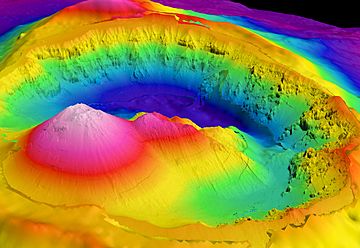Brothers Seamount facts for kids
Quick facts for kids Brothers Seamount |
|
|---|---|

Brothers Volcano as looking into the caldera from the south
|
|
| Summit depth | 1,350 m (4,430 ft) |
| Location | |
| Coordinates | 34°52′30″S 179°04′30″E / 34.875°S 179.075°E |
| Geology | |
| Type | Submarine volcano |
| Last eruption | Unknown |
The Brothers Seamount (also called Brothers Volcano) is a huge submarine volcano in the Pacific Ocean. It's part of a chain of volcanoes known as the Kermadec Arc. This underwater giant is located about 340 kilometers (210 miles) northeast of New Zealand's Whakaari/White Island. It's one of the many volcanoes found along the South Kermadec Ridge.
Contents
What is Brothers Volcano Like?
Brothers Volcano formed because of the movement of Earth's giant plates. The Pacific Plate is sliding under the Australian Plate. This movement creates cracks and faults in the Earth's crust. Magma then rises through these cracks, forming volcanoes like Brothers.
This volcano has an oval shape, about 13 kilometers (8 miles) long and 8 kilometers (5 miles) wide. It has a giant bowl-shaped crater called a caldera. This caldera is 3 kilometers (1.9 miles) wide. Its walls are very tall, ranging from 300 to 500 meters (980 to 1,640 feet) high. That's three times bigger than the caldera of White Island!
Inside the caldera, there's a large dome called the Upper Cone. It rises 350 meters (1,150 feet) from the caldera floor. The caldera floor itself is 1,850 meters (6,070 feet) below sea level. There's also a smaller dome nearby. Scientists have made detailed maps of the volcano using magnetic tools. These maps show that the magnetic highs are found around the caldera rim and the Upper Cone. The magnetic lows are in areas where hot water has changed the rocks.
Hot Springs Under the Sea
The walls of the caldera and the large dome are home to many hydrothermal vents. These are like hot springs on the ocean floor. They shoot plumes of super-hot water up to 750 meters (2,460 feet) into the ocean. Brothers Volcano is the most active hot spring volcano in the Kermadec Arc.
These hot springs have built tall structures called "black smoker" chimneys. Some of these chimneys are 8 meters (26 feet) high! They form when hot, mineral-rich water from inside the volcano mixes with the cold ocean water. The minerals then cool down and settle, building up these chimneys.
The hot water from these vents is full of energy. It supports many unique creatures that can live without sunlight. These include special tubeworms and bacteria. The marine life and minerals found near these chimneys are very important. They can help New Zealand's economy and its biotechnology industry. Scientists believe the richest mineral deposits are likely found along the caldera rim and walls.
There are two main types of hot spring activity at Brothers Volcano:
- In the Upper Caldera and NW-Caldera, there are very hot vents. These vents release gases and form chimneys rich in copper, zinc, and gold.
- At the Upper and Lower Cones, the water is not as hot (less than 120 °C or 248 °F). These vents release more gases and acidic fluids that contain sulfate.
When Did it Erupt?
Scientists don't know exactly when Brothers Volcano last erupted. However, the shape of its crater walls tells a story. It had such a powerful eruption that it caused the volcano to collapse, forming the large caldera.
Studies of rock samples from the volcano show it had two main stages of activity:
- Before the caldera collapsed, there was a lot of magma activity. This included a system of hot, acidic fluids and metal-rich brines.
- After the caldera collapsed, the Upper and Lower Cones grew. New hot spring activity also started.
Scientists from the United States, New Zealand, and Germany worked together to map the volcano in 2007. More samples were taken in 2018 during a special expedition. These studies helped them understand the volcano's history.
Watching Underwater Volcanoes
No single organization regularly monitors submarine volcanoes like Brothers. However, they are a major focus for many current scientific expeditions. Scientists are very interested in learning more about these hidden giants of the deep sea.
See also
 In Spanish: Volcán Brothers para niños
In Spanish: Volcán Brothers para niños
Images for kids



